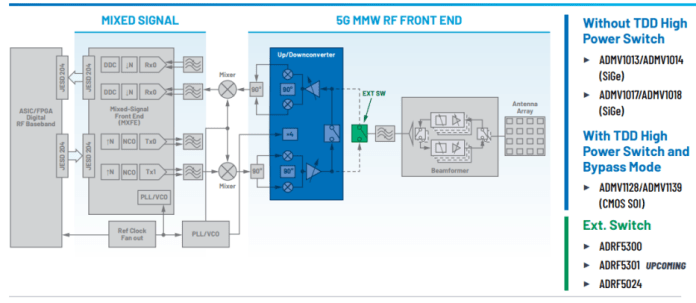Analog Devices Inc. (ADI) has expanded its 5G millimeter-wave (mmWave) front-end chipset portfolio to address the full 5G NR FR2 spectrum. Helping to reduce design complexity and develop smaller radios, the new Gen 2 chipset is comprised of four highly integrated ICs and provides a complete solution to reduce the number of components needed for 24- to 47-GHz 5G radios.
The new chipset, comprised of the ADMV4828 and ADMV4928 dual-polarization 16-channel beamformer ICs and ADMV1128 and ADMV1139 single-channel (1T1R) up-/down-converters (UDCs), builds on ADI’s Gen 1 ADMV1017 and ADMV1018 UDCs and ADMV4801 and ADMV4821 beamformer ICs. These devices are built on silicon germanium (SiGe) process technology.
The Gen 2 chipset, built on CMOS silicon-on-insulator (SOI) process technology, delivers several improvements over Gen 1 and competitive devices. “The new chipset delivers performance and cost improvement to enable deployment in a broader set of mmWave 5G use cases, including small cells, macrocells, and CPE [customer premise equipment], addressing both FWA [fixed wireless access] and mobility applications,” said Kerem Ok, product line director for ADI’s Communications BU/Microwave Communications Group.
“These ICs are characterized not only with 5G NR waveforms, but also with Wi-Fi 5/Wi-Fi 6 emerging as a lower-cost, faster time-to-market use case for commercial phased arrays in FWA applications and CPE uplink waveforms for client-side terminals,” he said.
The power efficiency and linear output power provided by the beamformers enable size, weight, power, and cost reduction in mmWave phased-array designs compared with competing solutions, according to ADI. In addition, full-band UDCs with high drive level eliminate the need for frequency-band variants and high integration delivers bill-of-materials savings. The chipset also enables operation of phased-array calibration functions online in the field in addition to non-volatile memory (NVM) factory calibration through patented IP.
The ADMV4828 is a 16-channel beamformer that covers the entire 24- to 29.5-GHz band in a single IC. Key specs include >12.5-dBm output power at 3% EVM with a 400-MHz 64-QAM 5G NR waveform while consuming 310 mW/channel. The ADMV4928 is a 16-channel beamformer, covering the entire 37- to 43.5-GHz band in a single IC. It provides >11.5-dBm output power at 3% EVM with a 400-MHz 64-QAM 5G NR waveform and consumes 340 mW/channel.
The new ADMV1128, a 24- to 29.5-GHz wideband UDC with optional on-chip RF switch and intermediate frequency (IF) hybrid features, offers ×2 or ×4 LO multiplier modes and baseband IQ support. The ADMV1139 is a 37- to 50-GHz wideband UDC for the upcoming 47 GHz, as well as the 37- to 43.5-GHz 5G NR bands, in a single IC with optional on-chip RF switch and IF hybrid features and baseband IQ support.

5G mmWave front-end up-converter/down-converter solutions. Click for a larger image. (Image: Analog Devices)
ADI is displacing incumbent startups that are at their third and fourth generation of CMOS devices with its first CMOS chipset thanks to lower power consumption and competitive pricing, said Ok.
The ADI Gen 2 chipset offers a reduction in power dissipation of approximately 40% compared with Gen 1 devices and a 15% to 20% reduction versus competing devices, he said.
Other improvements compared with Gen 1 devices include overall higher linear output power, expanded bandwidth to cover the 47-GHz 5G NR band as well as instrumentation applications up to 50 GHz, a reduction in different power rails and operation with a single 1.8-V supply, improved LO feedthrough and side-band–rejection calibration performance, and high gain and lower noise figure (NF). The chipset also offers higher IC integration (e.g., a high-power TDD switch integrated into the ADMV1128 and ADMV1139) as well as hybrid integration, IQ mode support, and smaller package sizes.
Ok said the biggest benefits include the 16 channels of beamformer in one IC, UDC coverage up to 50 GHz with only two ICs, and patented online calibration IP in addition to non-volatile factory calibration and patented digital predistortion (DPD) IP. Another advantage is ADI’s ability to customize solutions for greater differentiation.
All of the devices in the chipset are available now in full production. For pricing, contact mmWave5G@analog.com.
Advertisement
Learn more about Analog Devices







